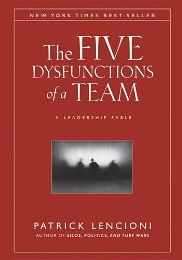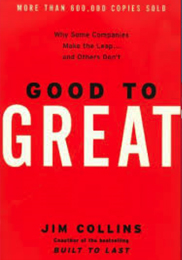October 2014: In This Issue
Welcome to the October issue of A New Leaf! As we enter the 2014 fourth quarter, focusing on completing a successful year and effectively addressing 2015 STRATEGY need to be high on all leader’s priority lists. Both will require a highly functional TEAM operating in a strong CULTURE supported by visionary LEADERSHIP.
This month’s issue provides overviews of two business classics that address these important execution and planning challenges. The books have been selected as each has remained on the best seller lists for over thirteen years. Their continued popularity speaks to the sustainability of each author’s message.
“The Five Dysfunctions of a Team” specifically addresses what it takes to be a highly functional TEAM. Without effectively dealing with team dysfunction, your ongoing execution and upcoming STRATEGY sessions will likely not achieve their intended objectives.
“Good to Great” sets forth research based findings on how even underperforming companies can transform themselves to achieve enduring greatness. The book offers intriguing revelations on all aspects of LEADERSHIP and CULTURE.
A key deliverable from your 2015 STRATEGY setting process should be the identification of how your business will differentiate itself from the competition. The concepts set forth in both books will assist you in establishing the cultural foundation necessary to achieve this critical strategic imperative.
- Mike
 Book Review: “The Five Dysfunctions of a Team” by Patrick Lencioni
Book Review: “The Five Dysfunctions of a Team” by Patrick Lencioni
Like his other bestsellers, Patrick Lencioni’s “The Five Dysfunctions of a Team” presents a case study written as a fable to illustrate the practical application of his message. Following the fable, he then provides a detailed assessment of the functional team model. His writing style proves both constructive in understanding the context of the team model and instructive in the review of its details.
Team dysfunction is prevalent in all organizations. The issue is not if it exists but whether leadership acknowledges and is actively working to overcome it. Lencioni sets forth the following five dysfunctions threatening peak team performance:
- Absence of Trust
- Fear of Conflict
- Lack of Commitment
- Avoidance of Accountability
- Inattention to Results
Consistent with successfully addressing team dysfunction, a high performing “functional team” knowingly chooses:
- Team Trust over individual feelings of Invulnerability
- Constructive Conflict over Artificial Harmony
- Commitment over Ambiguity
- Accountability over Low Standards
- Attention to Results over a focus on Status and Ego
Lencioni’s five dysfunctions are of a hierarchal nature. Absent trust, team members will fear and not engage in the conflict necessary to arrive at the best decisions. Not having engaged in constructive conflict, team members will be unwilling to provide the necessary commitment to the decisions made. Lacking full commitment, team members will avoid accountability for execution of decisions made. Failing to accept accountability, team members inevitably focus on their individual desires in lieu of paying attention to the collective results of the organization.
Lencioni goes into great depth in addressing the causes and cures of each of the key dysfunctions. An assessment tool is provided to establish a baseline as to where your team stands today and those dysfunctions it needs to focus on in the future.
Lencioni’s definitions of the dysfunctions are critical to the understanding of his model. In particular, the concepts of trust and accountability stand out in contrast to their standard use relating to organizational performance. Following is a brief discussion of Lencioni’s definition of these two important concepts.
In their quest for high performance, many teams are unable to overcome the primary dysfunction of team trust. The standard definition of trust, one that centers on the ability to predict one’s behavior based upon past experience, contrasts with Lencioni’s definition. The functional team model defines trust as “the confidence amongst team members that their peer’s intentions are good, and that there is no reason to be protective or careful around the group. In essence, team members must get comfortable being vulnerable with one another. This includes being open in sharing their mistakes and weaknesses”.
This level of trust is extremely hard to establish and usually requires time and shared experiences to develop. Unfortunately, absent the presence of this degree of vulnerability, teams will be unable to effectively engage in the kind of open dialogue and conflict necessary to arrive at the best decisions possible. This will significantly diminish their ability to become a high performing team.
Similarly, Lencioni’s definition of accountability offers a radically different perspective on this important team concept. If team members achieve the requisite level of trust, engage in the necessary conflict and commit to the decisions made, then the concept of accountability addresses “the willingness (and responsibility) of team members to call their peers on performance or behaviors that might hurt the team”. Members of great teams are not afraid to “enter the danger” zone of difficult conversations with each other. This rare level of peer accountability greatly reduces the responsibility of the leader to be solely responsible for the management of team performance. “Members of great teams improve their relationships by holding one another accountable, thus demonstrating that they respect each other and have high expectations for one another’s performance”.
“The Five Dysfunctions” sets forth a constructive framework for how teams can deliver outstanding results. If your team is underperforming, addressing the five dysfunctions will be a great place to start.
 Supplementary Book Review: “Good to Great” by Jim Collins
Supplementary Book Review: “Good to Great” by Jim Collins
In his original best seller “Built to Last”, Jim Collins set forth how great companies triumph over time in sustaining long term performance. “Good to Great” extends his research based findings in identifying how merely good companies can, over time, achieve greatness.
Collin’s research compared eleven transformational companies (“great companies”) to industry competitors that lagged or failed to make the transformational leap. He distilled his research findings into the following three stages and relevant concepts that were applicable to all great companies:
- Disciplined People
-Level 5 Leadership
-First Who, Then What
- Disciplined Thought
-Confront the Brutal Facts
-Hedgehog Concept
- Disciplined Action
-Culture of Discipline
-Technology Accelerator
The combination of the above stages and concepts comprise what Collins refers to as the Flywheel, which reflects the repeated process of great companies in relentlessly moving in a single direction, building momentum and ultimately “breaking through”. He is quick to contrast the Flywheel concept with that of the comparison companies whose actions more often reflected that of the Doom Loop.
All of Collin’s six concepts are critical to leaders looking to build a sustainable, high performing organization. The six concepts are presented in a chronological manner, with the first three representing the “build up” phase of the Flywheel while the latter three comprise the “breakthrough” phase. As summarized below, the results of the first stage of Disciplined People proved surprising even to Collins.
Level 5 Leadership - In lieu of high profile leaders, the type of leadership required to transform good companies into great ones was very different. Collins presents the following hierarchy of his Five Levels of Leadership:
Level 1-Highly Capable Individual
Level 2-Contributing Team Member
Level 3-Competent Manager
Level 4-Effective Leader
Level 5-Level 5 Executive
Leaders of the great companies consistently exhibit traits of Level 5 Leadership who “channel their ego needs away from themselves and into the larger goal of building a great company. It’s not that Level 5 leaders have no ego or self interest. Indeed, they are incredibly ambitious-but their ambition is first and foremost for the institution, not themselves. Collins notes that the research is conclusive in Level 5 leaders (being) a study in duality: modest and willful, humble and fearless."
Other key qualities of Level 5 leaders were that they:
- Went to great pains to set their successors up for even greater success
- Were fanatically driven, infected with an incurable need to produce sustained
results
- Displayed a workmanlike diligence-more plow horse than show horse
- Looked out the window to attribute success to factors other than themselves.
When things went poorly, they looked in the mirror and blamed themselves,
taking full responsibility.
Collins concludes his analysis noting that “We were not looking for (the existence of) Level 5 leadership in our research but the data was overwhelming and convincing. It is an empirical, not an ideological, finding."
The second concept of the Disciplined People stage focused on the First Who…Then What research finding. The key strategic takeaway from this research was that the great company leaders focused first on getting the right people on the bus and then figuring out where to drive it. The who preceded the what….coming even before such important cultural components as vision, strategy, structure and tactics.
The great company leaders were also rigorous in their people decisions, holding firm to the following three practical disciplines:
- When in doubt, don’t hire…keep looking.
- When you know you need to make a people change…act.
- Put your best people on your biggest opportunities…not your biggest problems.
Collins closes the analysis of First Who..Then What noting that he found no systematic pattern linking executive compensation to the shift from good to great. “Whether someone was the right person has more to do with character traits and innate capabilities than with specific knowledge, background or skills.”
Effectively dealing with Disciplined People challenges was the consistent first step in the successful transformation of the great companies. As you look to understand where you are positioned on the Collin’s Flywheel, assess your progress on Level 5 Leadership and First Who, Then What. The remaining four transformational concepts will be as challenging and revealing as these first two.©2013 See Change Management. All Rights Reserved. Site credit


